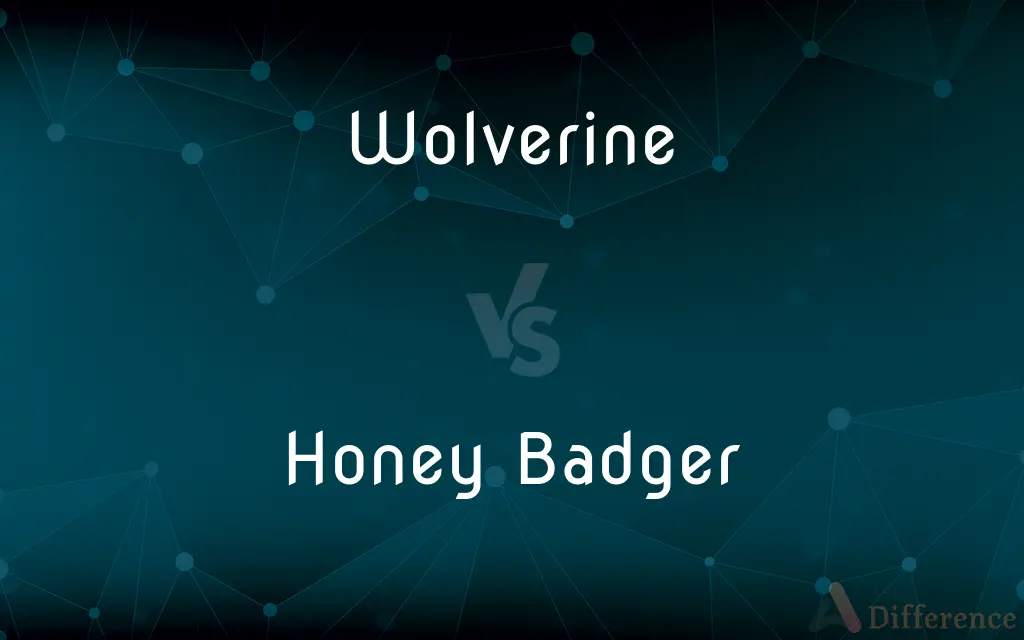Wolverine vs. Honey Badger — What's the Difference?
Wolverine is a large, carnivorous mammal found in northern regions, while Honey Badger is a fearless, carnivorous mammal native to Africa and Asia, known for its love of honey.

Difference Between Wolverine and Honey Badger
Table of Contents
ADVERTISEMENT
Key Differences
Wolverine and Honey Badger are both ferocious carnivorous mammals but belong to different families. While the Wolverine is part of the Mustelidae family and is closely related to weasels, the Honey Badger is also part of the Mustelidae family but represents a different subfamily, Mellivorinae.
The habitats of the Wolverine and Honey Badger differ significantly. Wolverines are usually found in the colder northern regions, including parts of North America, Europe, and Asia. In contrast, Honey Badgers are predominantly located in Africa and some parts of Southwest Asia, preferring drier regions, forests, and grasslands.
From a physical standpoint, Wolverines tend to be larger and have a stockier build compared to Honey Badgers. Wolverines feature a dark brown coat with light stripes, while Honey Badgers have a distinct sharp color separation, being mostly black with a white or gray back.
Behaviorally, both the Wolverine and Honey Badger are known for their incredible strength and ferocity. However, Honey Badgers have an added reputation for their love for honey and their ability to raid beehives, giving them their name. Wolverines, on the other hand, are solitary animals and often cover vast territories.
In terms of dietary habits, while both Wolverine and Honey Badger are carnivorous, Honey Badgers have a more varied diet, including insects, honey, and fruits. Wolverines primarily prey on larger animals and are also known to scavenge.
ADVERTISEMENT
Comparison Chart
Family
Mustelidae
Mustelidae (Subfamily: Mellivorinae)
Habitat
Northern regions (North America, Europe, Asia)
Africa, Southwest Asia
Physical Appearance
Larger, stocky, dark brown with light stripes
Smaller, black with a white or gray back
Diet
Carnivorous, preys on larger animals, scavenges
Varied: insects, honey, fruits, and animals
Behavioral Traits
Solitary, covers vast territories
Fearless, raids beehives, aggressive
Compare with Definitions
Wolverine
A large carnivorous mammal of northern regions.
The Wolverine is often seen as a symbol of wilderness and cold climates.
Honey Badger
A carnivorous mammal known for raiding beehives.
The Honey Badger braves bee stings to get to the delicious honey.
Wolverine
An animal with a dark brown coat and light stripes.
The distinctive markings of the Wolverine make it easy to identify.
Honey Badger
A mammal recognized for its boldness and tenacity.
Despite its size, the Honey Badger is often called the world's most fearless animal.
Wolverine
A member of the Mustelidae family related to weasels.
Despite its size, the Wolverine is closely related to smaller weasels.
Honey Badger
A creature with a black body and a white or gray back.
The striking appearance of the Honey Badger makes it unmistakable.
Wolverine
A fierce and solitary creature found in cold habitats.
In the snow, a Wolverine can travel great distances in search of food.
Honey Badger
A fearless animal with a varied diet.
A Honey Badger won't back down from a fight, even against larger predators.
Wolverine
A mammal known for its strength and ferocity.
Legends often exaggerate the might of the Wolverine, portraying it as invincible.
Honey Badger
A member of the Mustelidae family native to Africa and Asia.
Unlike the Wolverine, the Honey Badger thrives in warmer climates.
Wolverine
A solitary mustelid mammal (Gulo gulo) of northern regions, having a heavyset body, short legs, dark fur, and a bushy tail, and known for its aggressive predatory behavior. Also called carcajou, glutton, skunk bear.
Wolverine
A solitary, fierce mammal of the Mustelidae family, species.
Wolverine
A resident of Michigan
Wolverine
Wolverine of northern Eurasia
Wolverine
Stocky shaggy-coated North American carnivorous mammal
Common Curiosities
Are Wolverine and Honey Badger related?
Yes, both belong to the Mustelidae family, but they represent different subfamilies.
Are Wolverines and Honey Badgers the same size?
No, Wolverines are generally larger and stockier than Honey Badgers.
Where can you find Wolverines in the wild?
Wolverines are native to the northern regions, including parts of North America, Europe, and Asia.
Can Wolverines climb trees like Honey Badgers?
While both are capable climbers, Honey Badgers more frequently climb to raid nests.
Why is it called a "Honey" Badger?
It's named for its fondness for honey and its habit of raiding beehives.
Is the Wolverine endangered?
Wolverines are not globally endangered but are considered threatened in certain regions.
Are Wolverines good swimmers?
Yes, Wolverines are adept swimmers, often crossing rivers and lakes.
Which one is more aggressive, Wolverine or Honey Badger?
Both are known for their ferocity, but the Honey Badger is often labeled as the more aggressive of the two.
Do Wolverines eat honey like Honey Badgers?
No, Wolverines primarily prey on larger animals and aren't known for consuming honey.
What's the primary habitat of the Honey Badger?
Honey Badgers are found in drier regions, forests, and grasslands of Africa and Southwest Asia.
How do Wolverines and Honey Badgers protect themselves?
Beyond their aggressive nature, both have thick skin that offers protection against predators.
Share Your Discovery

Previous Comparison
Facilitated Diffusion vs. Active Transport
Next Comparison
Bilateral Trade vs. Multilateral Trade















































